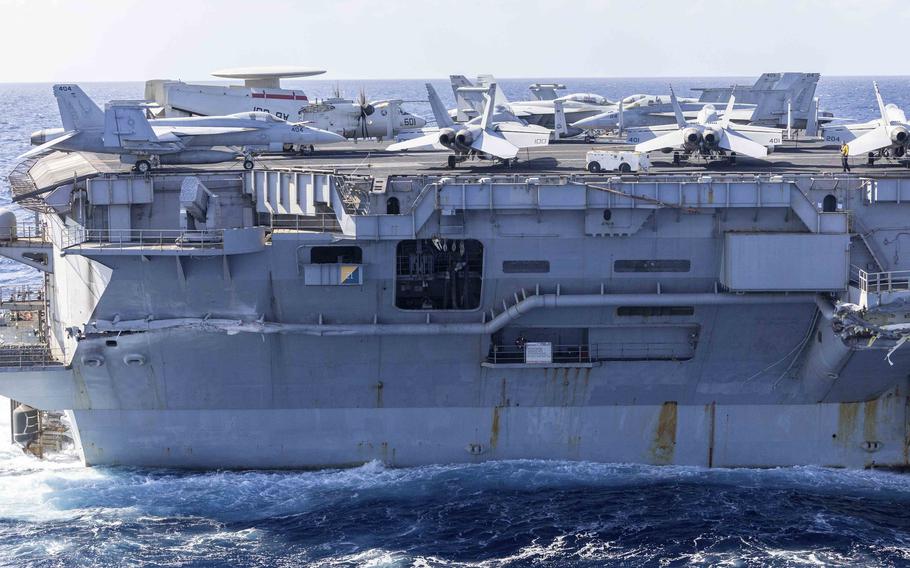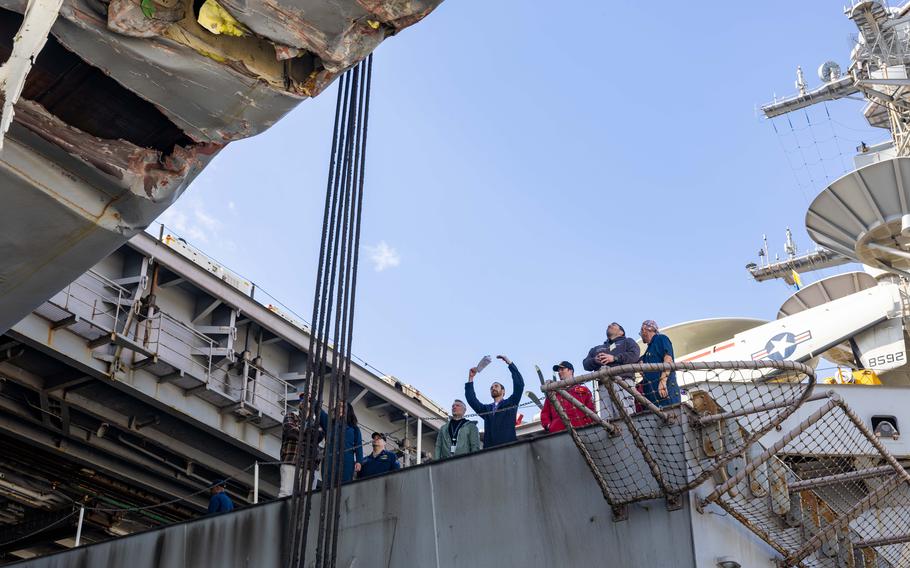
Exterior damage to USS Harry S. Truman is viewed from an MH-60S Sea Hawk helicopter Feb. 13, 2025, a day after the carrier's collision with the merchant vessel Besiktas-M near Port Said, Egypt. The ship is now at U.S. Naval Support Activity Souda Bay in Crete for repairs. (Jose Hernandez/U.S. Navy)
NAPLES, Italy — Navy inspectors are evaluating the structural integrity of the aircraft carrier USS Harry S. Truman after a collision with a cargo ship last week left scrapes and gashes along its right back end, including the hull.
That assessment, which began Sunday at Naval Support Activity Souda Bay on the Greek island of Crete, will cover Truman’s hull and bulkheads to ensure they can bear weight, U.S. 6th Fleet spokesman Cmdr. Timothy Gorman said Wednesday.
Bulkheads are interior vertical walls that form compartments within a ship.
A small slash penetrated the ship’s hull high above the waterline, Gorman said, adding that it’s too soon to say how long the inspection will take and when a comprehensive damage assessment will be available.
The evaluation won’t include Truman’s flight deck, said Gorman, noting that the carrier conducted flight operations Saturday, days after the Feb. 12 late-night collision with the Panama-flagged Besiktas-M near the Suez Canal.
There were no injuries or flooding in the collision, which damaged a line handling space, the fantail and a platform above a storage space. The exterior walls of two storage rooms and maintenance space also were included in initial damage assessments.

An inspection team studies the damage to the aircraft carrier USS Harry S. Truman on Feb. 16, 2025, at U.S. Naval Support Activity Souda Bay on the Greek island of Crete. The carrier was left with scrapes and gashes along its right back end after colliding with a cargo ship near the Suez Canal on Feb. 12, 2025. (Michael Gomez/U.S. Navy)
The ship’s nuclear propulsion plants were unaffected, and damage appeared to be above the waterline, the service said last week.
Those initial assessments, along with photographs showing mostly superficial damage to the ship’s starboard quarter side, likely mean Truman could be patched up and soon resume its deployment, analysts told Stars and Stripes.
“The maintenance capabilities at Souda Bay should be able to (provide) temporary repairs that should carry the ship through the rest of its deployment to the point where permanent repairs can be made,” said Steven Wills, a naval analyst with the Center for Maritime Strategy at the Navy League of the United States.
Wills and other analysts also pointed out that there are other suitable locations for repairs in the region, such as Croatia, France or Italy.
Unless more significant problems are discovered, such as something involving Truman’s propulsion system, the Navy likely will keep the carrier on station, said James Holmes, chair of the maritime strategy program at the Naval War College in Newport, R.I.
A shortened deployment and return to Norfolk, Va., could complicate a tight maintenance and deployment schedule for the service’s other 10 carriers, something the Navy would be eager to avoid, he said.
“You don’t lightly bring a ship home from deployment,” Holmes said.
Truman deployed in September, entering the Red Sea on Dec. 14 to defend against Houthi militant threats to shipping in the strategic waterway.
It remained there for nearly two months before departing from the Middle East and arriving along with embarked Carrier Air Wing 1 and the destroyer USS Jason Dunham at Souda Bay on Feb. 6 for a port visit.
The collision with Besiktas-M occurred after Truman had left Souda Bay, presumably to return to the Red Sea. The mishap remains under investigation.
Truman’s absence from the Middle East likely won’t hinder regional U.S. security efforts, which could include a surge in destroyers or other warships, if needed, Holmes said.
With an uneasy truce in Gaza and the Russian presence in the region reduced after the fall of the Bashar Assad regime in Syria, “things are relatively quiet,” he said.
“The region remains unsettled but in no obvious need of major firepower like a carrier air wing,” Holmes said. “You don’t need a carrier warplane for everything. That’s why we have surface action groups.”